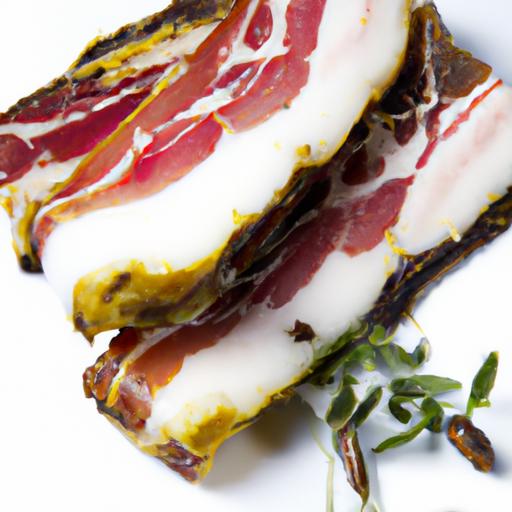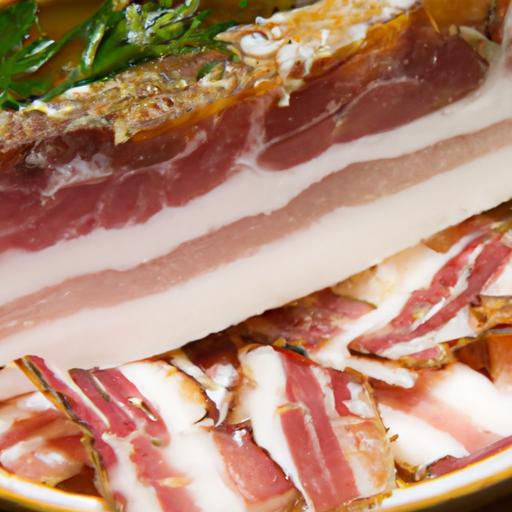There’s a magic that happens when simple ingredients meet time-honored tradition-and nowhere is this alchemy more deliciously evident than in guanciale. This uniquely flavorful Italian cured meat, made from pork jowl, is the secret soul of classic dishes like pasta all’amatriciana and carbonara, elevating them from ordinary to unforgettable. But crafting authentic guanciale is an art, a patient dance of curing, seasoning, and aging that transforms humble pork into silky, savory perfection. In this step-by-step guide, we’ll unlock the secrets of this cherished delicacy, revealing how you can bring the taste of Italy’s heartland into your own kitchen-one fragrant, luscious slice at a time.
Crafting Authentic Guanciale begins with the careful selection of the pork jowl, a cut prized for its rich marbling and succulent texture. Originating from the heart of Italian culinary tradition, this luscious ingredient lends a depth of flavor that’s simply unmatched, forming the backbone of this beloved cured delicacy.
Prep and Cook Time
- Preparation: 30 minutes (plus 7-10 days curing)
- Drying: 3 weeks to 1 month
- Total Time: Approximately 4-5 weeks
Yield
- About 1.5 lbs of guanciale from a 2.5-3 lb pork jowl
Difficulty Level
- Advanced – requires patience and attention to detail
Selecting the Ideal Pork Jowl for Rich Flavor and Texture
Begin with a beautifully fresh pork jowl, ideally sourced from heritage breed pigs for optimal fat distribution. Look for a supple, creamy-white fat layer streaked gently with rich pink meat. This balance of fat and muscle creates the luscious mouthfeel guanciale is celebrated for. Avoid troppo lean cuts; the fat is your flavor vessel. When possible, discuss with your butcher about the pig’s diet-pasture-raised animals yield the sweetest, most aromatic jowls, setting the perfect foundation for your cure.
Mastering the Curing Process with the Perfect Blend of Salt and Spices
Next, coat the pork jowl generously with a mixture of kosher salt, freshly cracked black pepper, dried thyme, crushed juniper berries, and a touch of crushed red chili flakes. This blend not only draws moisture but also imparts a complex aromatic character. Use about 2 tablespoons of salt per pound of meat, ensuring every nook is covered. Place the jowl in a non-reactive container, cover, and refrigerate for 7 to 10 days, turning every 48 hours to evenly cure the meat. The slow salt penetration intensifies the flavors while tenderizing the flesh beautifully.
Achieving the Ideal Drying Environment for Optimal Taste and Safety
Drying guanciale is an art that requires a controlled environment. Aim for 55-60°F (13-15°C) with 70-80% relative humidity to prevent surface hardening while safely drawing out moisture. A dedicated curing fridge or humidity-controlled cellar works best. Hang the cured jowl on a clean hook or place it on a rack allowing airflow on all sides. The drying phase lasts 3 to 4 weeks, during which the jowl transforms into silky, concentrated perfection. Patience is key-avoid rushing to prevent spoilage or uneven drying.
Tips for Slicing and Storing Guanciale to Preserve Freshness and Flavor
Once dried, wrap the guanciale in cheesecloth followed by parchment paper, then store it in the coolest part of your refrigerator. For best flavor retention, slice thinly using a sharp knife or a meat slicer at a 45-degree angle. This technique reveals the beautiful marbling and ensures delicate melts on the tongue. Use guanciale within 2 to 3 weeks once sliced. For longer storage, vacuum seal portions to maintain freshness without sacrificing texture and aromatic complexity.
Ingredients
- 1 whole pork jowl (2.5-3 lbs), skin removed
- 6 tbsp kosher salt
- 3 tbsp freshly cracked black pepper
- 1 tbsp dried thyme
- 1 tbsp crushed juniper berries
- 1 tsp crushed red chili flakes (optional)
Instructions
- Prepare the Pork Jowl: Trim excess skin but leave the fat intact. Pat dry thoroughly with paper towels.
- Make the Cure Blend: In a bowl, mix the kosher salt, black pepper, thyme, juniper, and chili flakes evenly.
- Apply the Cure: Rub the spice and salt blend all over the pork jowl, massaging into every crevice.
- Cure the Meat: Place the jowl in a non-reactive dish or container, cover, and refrigerate between 34-38°F (1-3°C). Flip every 48 hours for 7-10 days until firm and well-seasoned.
- Rinse and Dry: Gently rinse off the cure with cold water, pat completely dry with clean towels.
- Hang to Dry: Suspend the jowl in a humidity-controlled environment around 55-60°F and 70-80% humidity for 3-4 weeks, monitoring weekly to ensure no spoilage.
- Storage and Use: Once dried firm but still yielding a slight give, wrap in cheesecloth and parchment, refrigerate until ready to slice.
Chef’s Notes
- It’s vital to use gloves for handling during curing to avoid contamination.
- Experiment with warm spices-fennel or bay leaf can deepen aromatic layers.
- If humidity is too low, place a pan of water nearby to add moisture.
- Use a meat thermometer to track temperatures during curing and drying.
- Guanciale improves with age but don’t exceed 2 months of drying or it may become brittle.
Serving Suggestions
Celebrate your guanciale’s luscious flavor by thinly slicing and crisping gently in a hot pan until golden and fragrant. Use it to enrich carbonara, amatriciana, or simply dress a rustic salad of arugula and shaved pecorino. Garnish dishes with fresh herbs like sage or cracked black pepper to complement the pork’s smoky, spiced allure. For a rustic antipasto platter, pair slices with aged cheeses and crusty bread-a sublime taste of Italy’s culinary heritage.

| Nutrient | Per 30g Serving |
|---|---|
| Calories | 150 kcal |
| Protein | 8g |
| Carbohydrates | 0g |
| Fat | 13g |
For more on curing meats at home, explore Serious Eats’ curing guide. To deepen your knowledge about classic Italian cured meats, see our related Italian Cured Meats Guide.
Q&A
Q&A: Crafting Authentic Guanciale – A Step-by-Step Guide to Perfection
Q1: What exactly is guanciale, and why is it so special?
A1: Guanciale is an Italian cured meat made from pork jowl or cheeks. It’s prized for its rich, silky fat and tender texture, which imparts a unique depth of flavor to classic Italian dishes like pasta alla carbonara and amatriciana. Unlike pancetta or bacon, guanciale’s silky fat melts beautifully, giving recipes that perfect balance of savory richness and subtle sweetness.
Q2: How does guanciale differ from other cured pork products?
A2: Unlike bacon, which is smoked, guanciale is simply salted and cured, allowing the natural flavors of the pork cheek to shine. Pancetta is made from pork belly and usually rolled, but guanciale’s rich fat content and unrolled flat shape lend it a luxurious mouthfeel and a distinctive taste profile that’s less smoky and more nuanced.
Q3: What’s the first step in making authentic guanciale at home?
A3: Start with a beautifully fresh pork jowl from a trusted butcher-quality is king here! Next, prepare a curing mix of salt, sugar, and aromatic spices such as black pepper, thyme, and bay leaves. Thoroughly rub the cure into the meat, ensuring every nook and cranny is covered to promote even flavor absorption.
Q4: Why is patience important during the curing process?
A4: Curing is a slow, magical transformation. Guanciale typically cures for about three weeks in a cool, humid environment. This patience allows the salt and spices to deeply penetrate the meat, while enzymes work their alchemy, tenderizing and developing those signature complex flavors. Rushing the process risks a guanciale that’s either too salty or underdeveloped in taste.
Q5: How should guanciale be stored once cured?
A5: Once your guanciale has developed its perfect texture and flavor, wrap it in parchment paper and store it in a cool, dry place or the fridge. When you slice it thinly, it can last for several weeks-enough time to inspire a cascade of delicious meals!
Q6: What’s the best way to cook guanciale to highlight its flavor?
A6: Guanciale is often cooked low and slow to render out its fat without crisping too quickly. Sauté it gently until the edges are golden and irresistibly crispy but still tender inside. This luscious fat is the heart of many beloved dishes, infusing sauces with irresistible depth and aroma.
Q7: Can I experiment with flavors when curing guanciale?
A7: Absolutely! While traditional guanciale uses simple seasonings, adventurous cooks can add a touch of chili, fennel seeds, or even a splash of local wine to make their homemade guanciale truly personal. The key is to keep the balance – the pork’s natural flavor should always remain the star of the show.
Q8: What dishes shine brightest with authentic guanciale?
A8: Classic Italian dishes like Spaghetti alla Carbonara and Pasta all’Amatriciana live or die by the quality of guanciale. Its melt-in-your-mouth fat enriches sauces with deep umami and a hint of sweetness, making every bite heavenly. Beyond pasta, try adding guanciale to soups, stews, or even atop a gourmet pizza for an extra punch of authenticity.
Q9: Are there common pitfalls to avoid when making guanciale?
A9: Two big traps: over-salting and insufficient drying. Too much salt makes the guanciale overpowering; not letting it dry enough can encourage spoilage or a less appealing texture. Keep conditions cool and slightly humid, monitor the cure carefully, and trust the process for perfect results.
Q10: What’s the ultimate reward of making your own guanciale?
A10: Beyond the joy of creating something delicious from scratch, homemade guanciale carries a story of tradition, craftsmanship, and love for food. It’s a gateway to authentic Italian flavors that supermarket versions just can’t match-a true culinary triumph in your own kitchen.
Key Takeaways
As you embark on your journey to craft authentic guanciale, remember that patience and respect for tradition are your greatest ingredients. Each careful cure, every trimmed edge, and the slow transformation of pork jowl into a richly flavored masterpiece, brings you closer to a slice of Italian heritage. By following this step-by-step guide, you’re not just making guanciale-you’re preserving a culinary art that elevates simple dishes into unforgettable experiences. So, roll up your sleeves, embrace the process, and savor the reward of homemade perfection, one luscious bite at a time.


